Figure 8.
Mean normalized amplitude of each group (Chinese, English) per component (Na–Pb, Pb–Nb, FFR) and pitch height stimulus (L, M). Pooling across stimulus and component, Chinese amplitudes are larger than English. By component, mid pitch height (M) is larger than low (L) for both cortical components (Na–Pb, Pb–Nb; *** p < 0.0001); conversely, L is larger than M for the brainstem component (FFR; *** p < 0.0001). The mid pitch height also evokes larger amplitude in Na–Pb than FFR; contrariwise, Pb–Nb has larger amplitude than FFR. At the cortical level, the increase in magnitude of CPR components with increasing pitch height is consistent with an increase in synchronized neural activity according to a rate-based encoding scheme. At the brainstem level, the decrease in F0 magnitude of the FFR with increasing pitch height reflects a decrease in neural phase locking according to a temporal encoding scheme.

